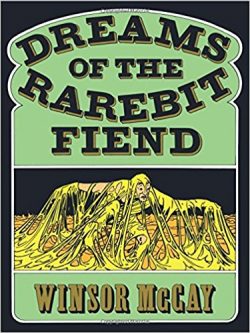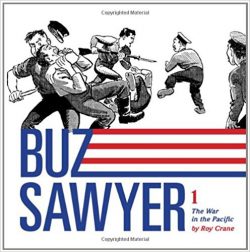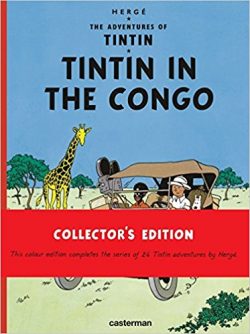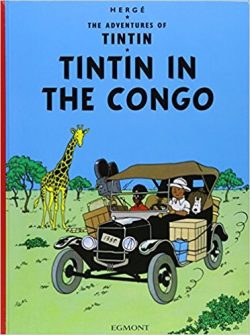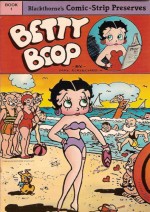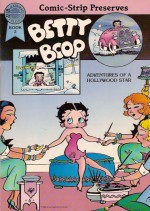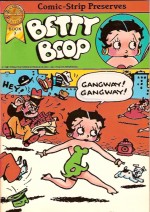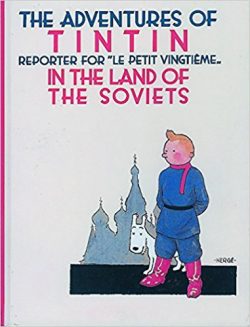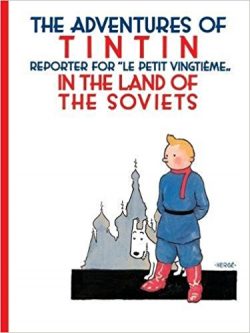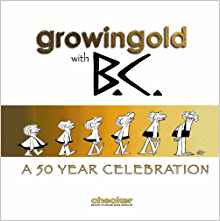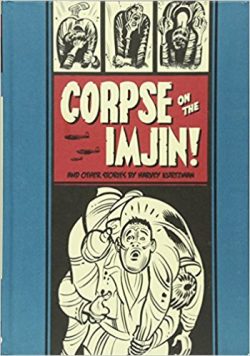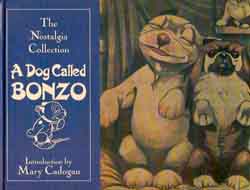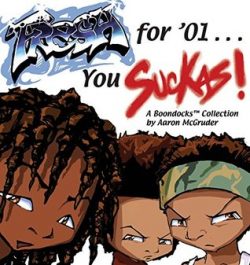

By George Herriman, edited by Bill Blackbeard (Fantagraphics Books)
ISBN: 978-1-56097-690-5
The Krazy Kat cartoon strip is, for many of us, the pinnacle of graphic narrative innovation; a singular and hugely influential body of work which shaped the early comics industry to become an undisputed treasure of world literature. It’s 105 years old and should be known and loved by far more folk than it is. Also worth remarking is that it may be the strangest and most authentic love story in comics history…
Krazy and Ignatz, as Fantagraphics designated its sequence of glorious archival tomes, is a creation which must be appreciated on its own terms. The feature evolved a unique language – at once both visual and verbal – to deal with the immeasurable variety of human experience, foibles and peccadilloes with unfaltering warmth and understanding without ever offending anybody.
Sadly, however, it baffled far more than a few…
Never a strip for dull or unimaginative people who simply won’t or can’t appreciate the complex multi-layered verbal and pictorial whimsy, absurdist philosophy or the seamless blending of sardonic slapstick with arcane joshing, it’s still the closest thing to pure poesy narrative art has ever produced.
George Herriman was already a successful cartoonist and journalist in 1913 when the cat and mouse who had been cropping up in his ever-evolving, outrageous domestic comedy strip The Dingbat Family/The Family Upstairs graduated to their own feature.
Krazy Kat debuted in William Randolph Hearst’s New York Evening Journal on Oct 28th 1913 and – largely by dint of the publishing magnate’s overpowering direct influence and hands-on interference – gradually spread throughout his vast stable of papers.
Although Hearst and a host of the period’s artistic and literary intelligentsia (such as e.e. Cummings, Frank Capra, John Alden Carpenter, Gilbert Seldes, Willem de Kooning, H.L. Mencken and others) all adored the strip, most local and regional editors did not; many taking every potentially career-ending opportunity to drop it from the comics section whenever they could.
Eventually the Kat found a home and safe haven in the Arts and Drama section of Hearst’s papers. Protected there by Hearst’s heavy-handed patronage, Krazy flourished, unharmed by editorial interference and fashion. One way or another and by hook or by crook Krazy ran – generally unmolested – until Herriman’s death in April 1944.
The core premise is simple: Krazy Kat is an effeminate, dreamy, sensitive and romantic feline of indeterminate gender hopelessly in love with rude, crude, brutal, mendacious, thoroughly scurrilous Ignatz Mouse.
Ignatz is a truly unreconstructed and probably irredeemable male; drinking, stealing, fighting, conniving, constantly neglecting his wife and children and always abusively responding to Krazy’s genteel advances by clobbering the Kat with a well-aimed brick (obtained singly or in bulk from noted local brick-maker Kolin Kelly). The smitten kitten invariably misidentifies these assaults as tokens of equally recondite affection.
The third crucial element completing an anthropomorphic eternal triangle is local cop Offissa Bull Pupp; a figure of honesty and stolid duty completely besotted with Krazy. Ever vigilant, he is professionally aware of the Mouse’s true nature, yet hamstrung – by his own amorous timidity and sense of honour – from permanently removing his devilish rival for the foolish feline’s affections.
Krazy is, of course, blithely oblivious to Pupp’s dilemma and has cast him eternally into what we now call the “Friend Zoneâ€â€¦
Crowding out the ever-mutable stage are a stunning supporting cast of inspired bit players such as Joe Stork (dreaded deliverer of unplanned, and generally unwanted, babies); hobo Bum Bill Bee; unsavoury conman trickster Don Kiyoti; self-aggrandizing Walter Cephus Austridge; fussbudget busybody Pauline Parrot, inscrutable, barely intelligible Chinese mallard Mokk Dukk; dozy Joe Turtil and a host of other audacious animal krackers, all equally capable of stealing the limelight or even supporting their own strip features.
The exotic, quixotic episodes occur in and around the Painted Desert environs of Coconino (based on the artist’s Coconino County, Arizona vacation retreat) where absurdly surreal playfulness and the fluid ambiguity of both flora and landscape are perhaps the most important member of the cast.
The strips are a masterful mélange of unique experimental art: wildly expressionistic and strongly referencing Navajo and Mexican art forms whilst graphically utilising sheer unbridled imagination and delightfully evocative lettering and language.
Those bizarre balloons and chaotic captions are crammed with florid verbiage: alliterative, phonetically and even onomatopoeically joyous with a compelling musical force (“l’il dahlinkâ€, “You is inwited to a ketnip potty or “so genteel, so riffime, so sobaâ€)…
Yet for all that, these adventures are lyrical, satirical, timely, timeless, bittersweet, self-referential, fourth-wall bending, eerily idiosyncratic, astonishingly hilarious escapades encompassing all aspects of humour from painfully punning shaggy dog stories to riotous, violent slapstick.
Sometimes Herriman even eschewed his mystical mumblings and arcane argots for the simply sublime grace of a supremely entertaining silent gag in the manner of his beloved Keystone Cops and other stars of silent slapstick comedies…
Krazy Kat‘s resurgence started in the late 1970s when the strip was rediscovered by a better-educated, open-minded and far more accepting generation. This top notch tinted tome – offering material from 1935-1936 – luxuriates in the switch to full colour (after decades of monochrome mirth and madness) under the sheltered safe-haven of a nationally-controlled Hearst comics insert package and manifests as a comfortably tactile paperback or eBook edition.
It was the first collection “Coalescing the Complete Full-Page Comics Strips, with the usual extra Rarities†such as candid photographs, contemporary press articles, toys, merchandise and even a 1916 original Krazy Kat page sublimely hand-tinted by Herriman to open this volume…
The precarious history of how these ultra-rare later strips were preserved and returned to print once more are detailed in Bill Blackbeard’s Introduction ‘Autumn Leaves: Herriman’s Klosing Kat Pages Revel in Fine Syndicate Kolur (But with a Briefly Blue Ignatz)’: supplemented by an examination of Herriman’s unclear – if not positively murky – past, potential ethnicity and the strip’s treatment of race issues in Jeet Heer’s article ‘The Kolors of Krazy Kat’.
Augmenting the journalism and sociology are a number of early strips plus a few magnificent painted pieces from the maestro, as well as a selection of merchandising treasures to ogle over and lust after…
The actual strip pages resume with June 1st 1935 – the colour provided by professional separators rather than Herriman – and pretty much pick up where the black and white feature left off.
We do, however, meet some new characters: perambulating elephants; an entrepreneurial cow; a Mocking Bird called Moggin Boid; doleful doggie and tax-dodging calf L’il Thinn Dyme and dismal dodo Dough Dough amongst others.
The most significant debuting presence is a thoroughly brutal bad guy dubbed “the Growlerâ€. This deplorable mutt adds a frisson of dangerous gangsterism to the aura of domestic dispute and romantic disharmony. Although the surly bandit easily outmatches and cows Offisa Pupp, he is clearly no match for the tangled trio working what we’ll kindly designate as “togetherâ€â€¦
Despite having to split his time between watching the mouse, confronting the Growler, administrating tax and dole crises and freeing the county of generalised sin and depravity, the lawdog soon settles into a comfortable pattern of wishful monitoring in these strips as Ignatz and Krazy perpetuate their bizarre romantic ritual. The Mouse constantly innovates in his obsessive desire to bean the Kat’s bonce: generally ending up in the cells whether successful or otherwise.
The Kat kontinues to await bad love’s brainbusting kiss, joyous of every kontusion and konkussion and deflated and woeful every time fate, cruel misfortune or the konstabulary aborts that longed for high-velocity assignation…
Pupp still proactively stalks and thwarts Ignatz, but as always, the mouse’s continual search for his ammunition of choice and the perfect ambush spot hogs most pages, leading to many brick-based gags and increasing frustration amongst all involved.
The county lock-up remains a key component as escalating slapstick silliness frequently concludes with Ignatz in the dog’s “houseâ€. Naturally, that just means the malign Mus Musculus maximising his malevolent efforts; regularly taking to the air or adopting uncanny disguises to achieve his aims…
New topics of interest and comedic provenance include the arrival of novel and challenging foodstuffs to the region – tortillas, water-melons and an assortment of fast foods. Also numbering amongst new arrivals and fresh phenomena are a film crew lensing authentic and reasonable romantic encounters, ghost sightings, unoccupied top hats, overly-effective hair restorers, a smoking ban, trick photography, beauty salons for pelt/skin tone reassignment procedures, boomerangs and strange lights in the sky…
Worst of all, with 1936 a Leap Year, the populace all seem to lose their bearings and become marriage mad even as Joe Stork – whose delivery of unexpected babies still brings dread responsibility and smug schadenfreude in equal amounts to all – expands his remit by becoming a self-appointed truant officer to Ignatz’ many progeny …
The region abounds with a copious coterie of confidence tricksters – a scurrilous sub-population which seems to grow weekly – but a new addition is a clique of nouveau riche billionaires and trillionaires seeking to increase their short-term assets before the year ends with a nasty outbreak of election fever and bogus prognostication…
As always there is a solid dependence on the strange landscapes and eccentric flora – especially the viciously ferocious coconuts and various cacti – for humorous inspiration, and bizarre weather plays a greater part in inducing anxiety and bewilderment. Strip humour was never more eclectic or indefinable…
Supplementing the cartoon gold and ending this slim tome is another erudite and instructional ‘Ignatz Mouse Debaffler Page’, providing pertinent facts, snippets of contextual history and necessary notes for the young and potentially perplexed before the collection closes with a fabulous photo feature on possibly the very first Krazy Kat stuffed toy and a selection of pinback buttons (we Brits call them badges) from the 1910s-1930s.
Herriman’s epochal classic is a phenomenal achievement: in all the arenas of Art and Literature nothing has been seen like these comics which shaped our industry and creators: inspiring auteurs in fields as disparate as prose fiction, film, dance, animation and music, all whilst delivering delight and delectation to generations of wonder-starved fans on a daily and weekly basis.
If, however, you’re one of Them and not Us, or if you yet haven’t experienced this gleeful graphic assault on the sensorium, mental equilibrium and emotional lexicon concocted by George Herriman from the dawn of the 20th century until the dog days of World War II, this astounding compendium is a supremely effective and accessible way to do so.
© 2005 Fantagraphics Books. All rights reserved.
